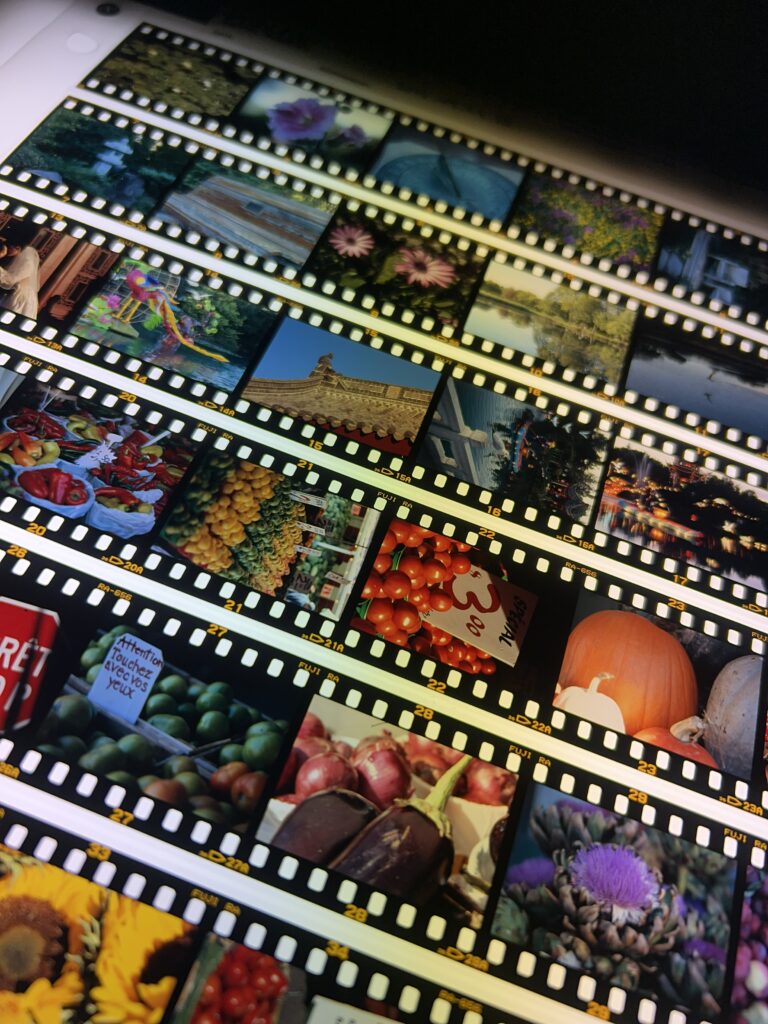I have been going through a back log of archiving film. I’m bad, as the most recent was 10 year old. Also that mean I haven’t shot film in 10 years. After some manual labour and digging for the metadata, I pulled the light table and went through some older archived film, including slide film. They are all in translucent archival “PrintFile” sheet, so they can be examined directly. Here is the view of the light table with such a page:

WOW. This is what I remember of the joy of shooting slide film: looking at the small images on the table. It’s like magic. Not even the thumbnails on the computer bring that joy. It must be the backlit transparency, the punchy colours. And I never shot slide film in medium format.
The experience
But how was it to shoot colours slide film? Even in 2000 it was expensive, more that colour negative. The rolls, the processing all more expensive, and harder to find. That put aside, it was also harder to shoot. Unlike for colour negative, inversible film (the other name of slide film) had much less latitude exposure (around ±1/2 a stop). While colour negative could easily get 2-4 stops each way and still get something usable, slide film couldn’t. And in a very contrasted scene you might have blown highlights or very dark shadows. Metering had to be much more precise and the resulting image could hardly be improved, which also made a lot of consumer point and shoots not suitable.
Slide film remained the preferred format for professional photography in publishing, until they switched to a digital workflow.
The results
Unlike negatives that needs to be printed, and for which the final results were linked to both the printing machine and its operator, slide appeared as close to the “final” product, and in the early days couldn’t even be printed as is. Slide film is the closest to JPEG SooC (Straight-out-of-Camera) in the digital world, and today, if you shoot Fujifilm camera, there are built-in the film simulations, and lot of user created settings. With the Lumix S9, the addition of LUT for stills also reinforce that trend, where cameras adopt a colour rendition model.
In the end
Now this is just nostalgia. Slide film today cost a lot, something like CA$35 a roll either in 135 (36 exposures) or 120 (I get 12 on my 6×6 TLR) and there is mostly only the new Kodak Ektachrome 100 from 2018 (after it got discontinued in 2012). I vividly remember as a roll was less than CA$10, that a price increase in 2004 triggered my purchase of my first DSLR, a Canon 20D. In retrospect I regret maybe not shooting more of it while it was still reasonable, and while these amazing Fujifilm Velvia and Provia were still relatively easily available. Some calculated the Kodachrome, the parent of all slide films, that got discontinued in 2010, cost more adjusted for inflation than Ektachrome in 2024 when it was released in 1935.
So should you shoot slide film? If you have a film camera that works well and you can measure the exposure properly, you should absolutely try. Make sure you have a way to get it processed as well. Not all labs do it.
Previously: What slide film taught me.